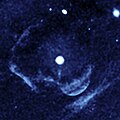Datei:Gas Shell Around Z Cam.jpg

Originaldatei (1.800 × 1.800 Pixel, Dateigröße: 1,98 MB, MIME-Typ: image/jpeg)
![]()
Diese Datei und die Informationen unter dem roten Trennstrich werden aus dem zentralen Medienarchiv Wikimedia Commons eingebunden.
Beschreibung
| BeschreibungGas Shell Around Z Cam.jpg |
English: This enhanced image from the far-ultraviolet detector on NASA's Galaxy Evolution Explorer shows a ghostly shell of ionized gas around Z Camelopardalis, a binary, or double-star system featuring a collapsed, dead star known as a white dwarf, and a companion star.
The image was processed to enhance the diffuse emissions from the shell. Z Cam is the bright object near the center of the image. Parts of the shell are seen as a lobe-like, light- blue feature below and to the right of Z Cam, and as two large, light blue, perpendicular lines on the left. The massive shell around Z Cam provides evidence of material ejected during and swept up by a powerful nova eruption, called a classical nova, which likely occurred a few thousand years ago. In exploding binary systems, one of the two stars steals material from the other until it builds up to a certain level; at that point, the system erupts in a giant inferno. In the case of Z Cam, the white dwarf is pilfering material from its sedate companion. There are two classes of exploding binary star systems, or cataclysmic variables: recurrent dwarf novae, which erupt in small, "hiccup-like" blasts episodically, and classical novae, which undergo huge explosions thousands of times more powerful than dwarf novae. Z Cam was the one of the first known recurrent dwarf novae. Yet the shell of ionized gas around Z Cam detected by the Galaxy Evolution Explorer can only be explained as the remnant of a full-blown classical nova explosion. The discovery of the shell provides the first evidence that some binary systems undergo both types of explosions. Previously, a link between the two types of novae had been predicted, but there was no evidence to support the theory. The Galaxy Evolution Explorer first began imaging Z Cam in 2003; this image was taken on Jan. 25, 2004. The type of emission found around Z Cam is most easily visible at far- ultraviolet wavelengths. Most of the background galaxies and stars have been eliminated by the image processing, although a few linger as white spots near the top. The light-blue streaky clump in the bottom right corner is created by ultraviolet light reflected by dust. It is uncertain if Z Cam is the source of the dust-scattered light. |
| Datum | |
| Quelle | http://www.galex.caltech.edu/media/glx2007-01r_img03.html |
| Urheber | NASA/JPL-Caltech/T. Pyle(SSC)/R. Hurt(SSC) |
Lizenz
| Public domainPublic domainfalsefalse |
| Diese Datei ist gemeinfrei (public domain), da sie von der NASA erstellt worden ist. Die NASA-Urheberrechtsrichtlinie besagt, dass „NASA-Material nicht durch Urheberrecht geschützt ist, wenn es nicht anders angegeben ist“. (NASA-Urheberrechtsrichtlinie-Seite oder JPL Image Use Policy). |  | |
 |
Warnung:
|
Kurzbeschreibungen
In dieser Datei abgebildete Objekte
Motiv
Dateiversionen
Klicke auf einen Zeitpunkt, um diese Version zu laden.
| Version vom | Vorschaubild | Maße | Benutzer | Kommentar | |
|---|---|---|---|---|---|
| aktuell | 15:44, 30. Jun. 2011 |  | 1.800 × 1.800 (1,98 MB) | wikimediacommons>Spitzersteph |
Dateiverwendung
Die folgende Seite verwendet diese Datei:
Metadaten
Diese Datei enthält weitere Informationen (beispielsweise Exif-Metadaten), die in der Regel von der Digitalkamera oder dem verwendeten Scanner stammen. Durch nachträgliche Bearbeitung der Originaldatei können einige Details verändert worden sein.
| Breite | 1.800 px |
|---|---|
| Höhe | 1.800 px |
| Art der Kompression | Unkomprimiert |
| Pixelzusammensetzung | RGB |
| Kameraausrichtung | Normal |
| Anzahl Komponenten | 3 |
| Horizontale Auflösung | 300 dpi |
| Vertikale Auflösung | 300 dpi |
| Datenausrichtung | Grobformat |
| Software | Adobe Photoshop CS3 Macintosh |
| Speicherzeitpunkt | 18:07, 3. Mär. 2008 |
| Farbraum | Nicht kalibriert |